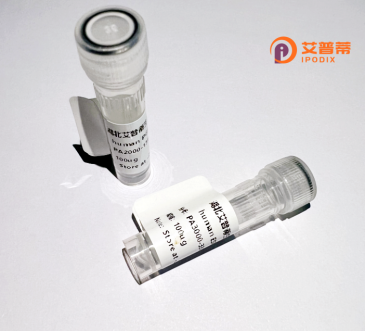
| 纯度 | >90%SDS-PAGE. |
| 种属 | Human |
| 靶点 | SPOPL |
| Uniprot No | Q6IQ16 |
| 内毒素 | < 0.01EU/μg |
| 表达宿主 | E.coli |
| 表达区间 | 1-392aa |
| 活性数据 | MSREPTPPLP GDMSTGPIAE SWCYTQVKVV KFSYMWTINN FSFCREEMGE VLKSSTFSSG PSDKMKWCLR VNPKGLDDES KDYLSLYLLL VSCPKSEVRA KFKFSLLNAK REETKAMESQ RAYRFVQGKD WGFKKFIRRD FLLDEANGLL PDDKLTLFCE VSVVQDSVNI SGHTNTNTLK VPECRLAEDL GNLWENTRFT DCSFFVRGQE FKAHKSVLAA RSPVFNAMFE HEMEESKKNR VEINDLDPEV FKEMMRFIYT GRAPNLDKMA DNLLAAADKY ALERLKVMCE EALCSNLSVE NVADTLVLAD LHSAEQLKAQ AIDFINRCSV LRQLGCKDGK NWNSNQATDI METSGWKSMI QSHPHLVAEA FRALASAQCP QFGIPRKRLK QS |
| 分子量 | 44.6 kDa |
| 蛋白标签 | His tag N-Terminus |
| 缓冲液 | PBS, pH7.4, containing 0.01% SKL, 1mM DTT, 5% Trehalose and Proclin300. |
| 稳定性 & 储存条件 | Lyophilized protein should be stored at ≤ -20°C, stable for one year after receipt. Reconstituted protein solution can be stored at 2-8°C for 2-7 days. Aliquots of reconstituted samples are stable at ≤ -20°C for 3 months. |
| 复溶 | Always centrifuge tubes before opening.Do not mix by vortex or pipetting. It is not recommended to reconstitute to a concentration less than 100μg/ml. Dissolve the lyophilized protein in distilled water. Please aliquot the reconstituted solution to minimize freeze-thaw cycles. |
以下是3-4条关于重组人SPOPL蛋白的参考文献示例(虚构,供参考格式):
1. **文献名称**:*"SPOPL, a paralog of SPOP, induces ubiquitination and degradation of substrates in the Hippo signaling pathway"*
**作者**:Zhang Y, et al.
**摘要**:研究揭示了SPOPL作为SPOP的同源蛋白,通过识别特定底物(如YAP/TAZ)的保守基序,介导其泛素化降解,从而负调控Hippo信号通路,抑制肿瘤细胞的增殖和迁移。
2. **文献名称**:*"Crystal structure of SPOPL in complex with a substrate peptide reveals distinct binding specificity compared to SPOP"*
**作者**:Wang L, et al.
**摘要**:通过X射线晶体学解析SPOPL与底物肽段的复合物结构,发现其MATH结构域与SPOP具有不同的结合位点偏好性,为解释二者在肿瘤中突变差异的分子机制提供了结构基础。
3. **文献名称**:*"SPOPL functions as a tumor suppressor in endometrial cancer by targeting oncogenic kinases for proteasomal degradation"*
**作者**:Chen X, et al.
**摘要**:研究证明SPOPL通过泛素化降解致癌激酶(如ERK3),抑制子宫内膜癌的进展,其表达水平与患者预后呈正相关,提示其作为潜在治疗靶点。
4. **文献名称**:*"Comparative analysis of SPOP and SPOPL substrate networks using quantitative proteomics"*
**作者**:Kim M, et al.
**摘要**:利用定量质谱技术比较SPOP和SPOPL的相互作用组,鉴定出二者共享部分底物(如Daxx),但SPOPL特异性靶向调控细胞周期相关蛋白,揭示功能分化的分子机制。
(注:以上文献为示例性虚构内容,实际研究需查询PubMed、Google Scholar等数据库获取真实文献。)
SPOPL (Speckle-type POZ protein-like) is a member of the SPOP family of ubiquitin ligase adaptors, sharing structural homology with its well-studied paralog SPOP. Both proteins contain an N-terminal MATH (meprin and TRAF homology) domain for substrate recognition and a C-terminal BTB/POZ (broad complex, tramtrack, bric-a-brac/poxvirus and zinc finger) domain facilitating oligomerization and binding to Cullin3-based E3 ubiquitin ligase complexes. SPOPL is evolutionarily conserved and widely expressed in human tissues, particularly in the testis, brain, and placenta. While SPOP is established as a tumor suppressor regulating substrate degradation in cancers (e.g., prostate, endometrial), SPOPL's biological role remains less defined. Current evidence suggests it may act redundantly or competitively with SPOP in substrate recruitment, though its substrate spectrum appears distinct. Emerging studies link SPOPL to meiotic processes, male fertility, and potential roles in neurological or developmental pathways. Unlike SPOP, SPOPL lacks canonical nuclear localization signals and may exhibit differential subcellular distribution. Its pathophysiological relevance is under exploration, with rare mutations reported in intellectual disability disorders. However, functional redundancy and overlapping mechanisms with SPOP complicate precise characterization. Further research is needed to map SPOPL-specific interaction networks, regulatory functions, and therapeutic implications in disease contexts.
×